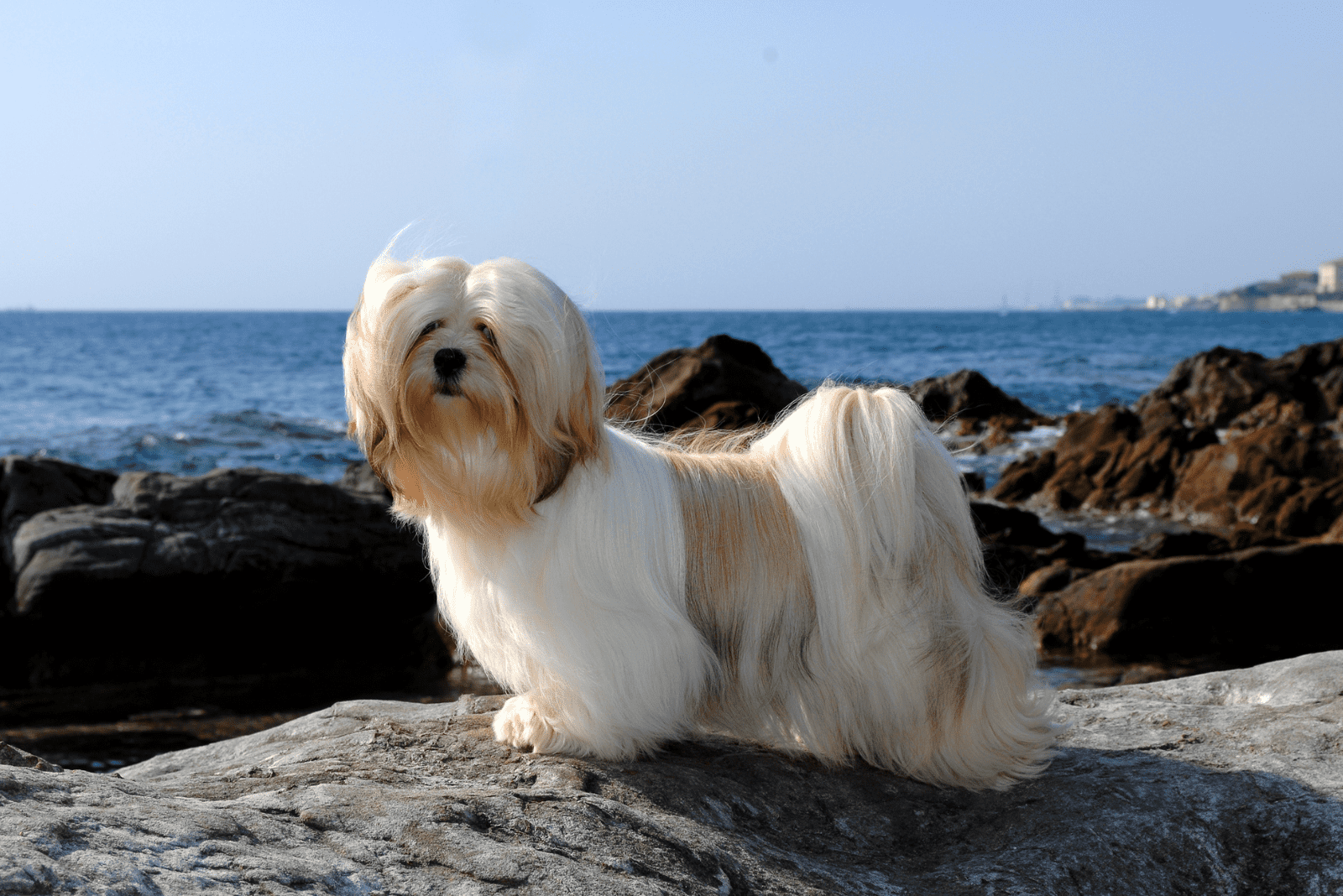The Lhasa Apso is a smart Himalayan dog that balances independence with love and loyalty. Multiple studies have shown that the Lhasa Apso is one of the oldest dog breeds in the world!
The Lhasa Apso is an ancient breed that originated in Tibet’s mountains. The Lhasa is named after the holy city of Lhasa, where Buddhist priests raised them in monasteries so that they would roam as sentinels.
These guard dogs were protected by their heavy, lengthy coats when they stood guard in Tibet‘s extreme weather. The Lhasa Apso colors helped them to blend in with both the natural setting of the Himalayan mountains and the beautiful interiors of Buddhist monasteries.
The most common Lhasa Apso colors include gold, cream, and honey, but they are also found in dark-grizzle, slate, smoke, and other shades of brown, white, and black. As a puppy gets older, its coat frequently changes hues.
If you are wondering what all of these Lhasa Apso colors look like, stay tuned!
Lhasa Apso Colors: Standard Colors
Ever since the purebred Lhasa Apso dog found its place on the list of the American Kennel Club registered dog breeds, the AKC has stated the official Lhasa Apso breed standards, where its coat colors are named.
The American Kennel Club (AKC) recognizes Lhasa Apso dogs that come in any of the eight standard colors, along with markings. Each Lhasa Apso that is registered can only have one color option and one type of marking.
Here’s the catch, if a Lhasa Apso isn’t colored in any of the following standard colors described by the American Kennel Club, it cannot be officially registered.
So, if you are looking for a show Lhasa Apso dog, get yourself a pooch that comes in any of these colors:
1. Grizzle Lhasa Apso
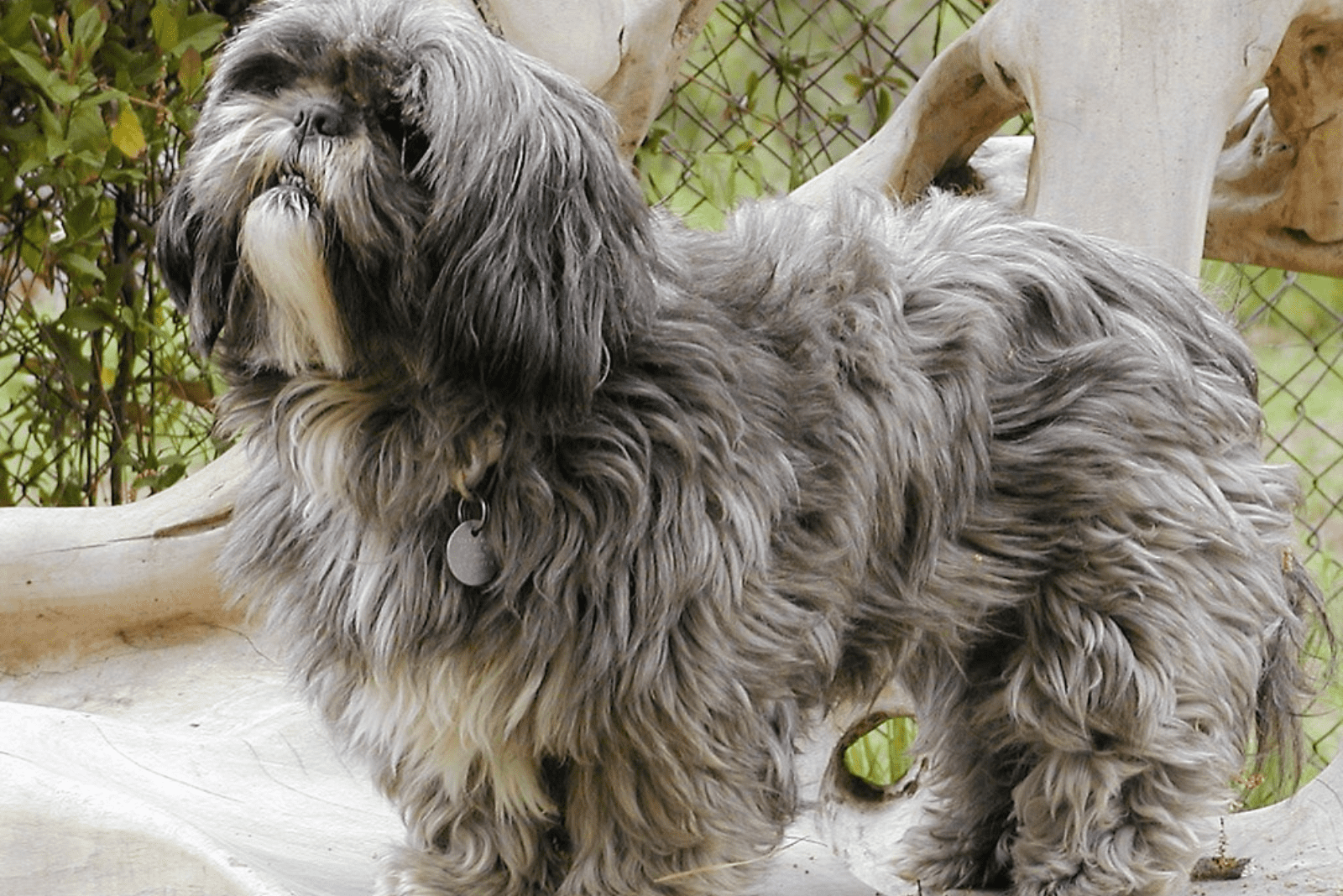
Grizzle is a color pattern that appears on the Lhasa Apso’s fancy coat as mixed hair with no discernible pattern.
When you look closely at a Lhasa Apso puppy, the colors appear blended together, giving the impression that there is only one color. In reality, the grizzle coat coloring combines lots of colorful hairs, including black, tan, white, or brown hairs.
Sometimes, white hair is mixed with black, which gives a grayish appearance to the grizzle Lhasa Apso. This is also because black tips on hairs combined with a beige to cream base color give a remarkable grizzle touch to the Lhasa Apso’s coat.
The grizzle coat color is a bit hard to describe but we have some examples for you. The most similar dog breed is the Border Terrier and many Border Terrier breeders offer grizzle puppies. In fact, both of these Terriers are often mixed with Lhasa Apsos!
However, it is not entirely known how a purebred grizzle Lhasa Apso got its coat color. It’s all up to genetics anyway!
2. Red Gold
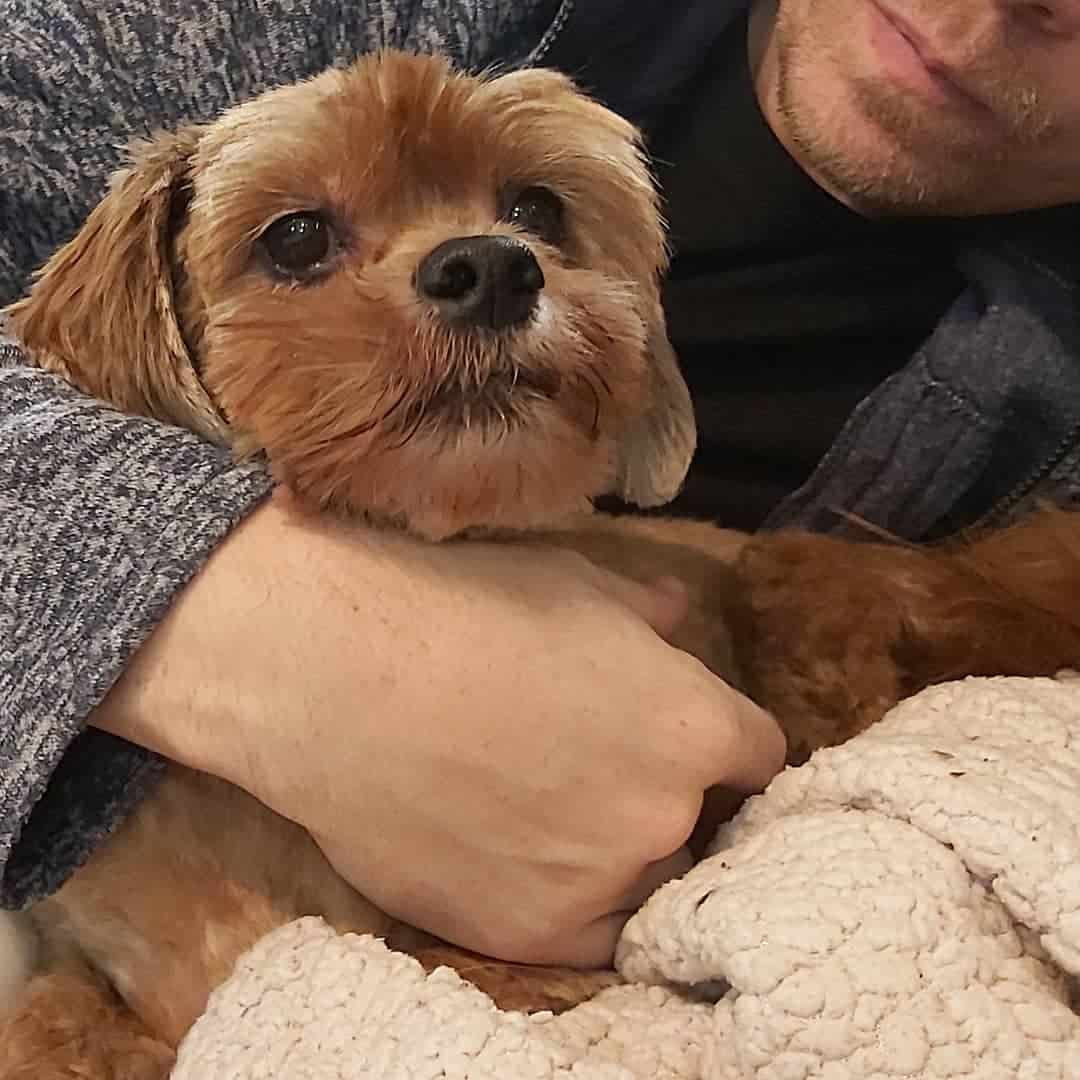
Photo from: @forsmanpia
The red hue is not as diluted as we see it in the red merle Australian Shepherd, it resembles more of the shade of a red Boston Terrier.
Just like in most other dog breeds, Lhasa Apsos red gold is not literally red gold. The red is commonly a shade of brown, chocolate, or liver color, while the gold color leans more towards yellow and orange hues.
Red hairs in red gold Lhasa Apsos are extremely shiny, especially when exposed to the sunlight. Undoubtedly, the red gold Lhasa Apso puppy is a small dog with a remarkable appearance!
3. Black Lhasa Apso
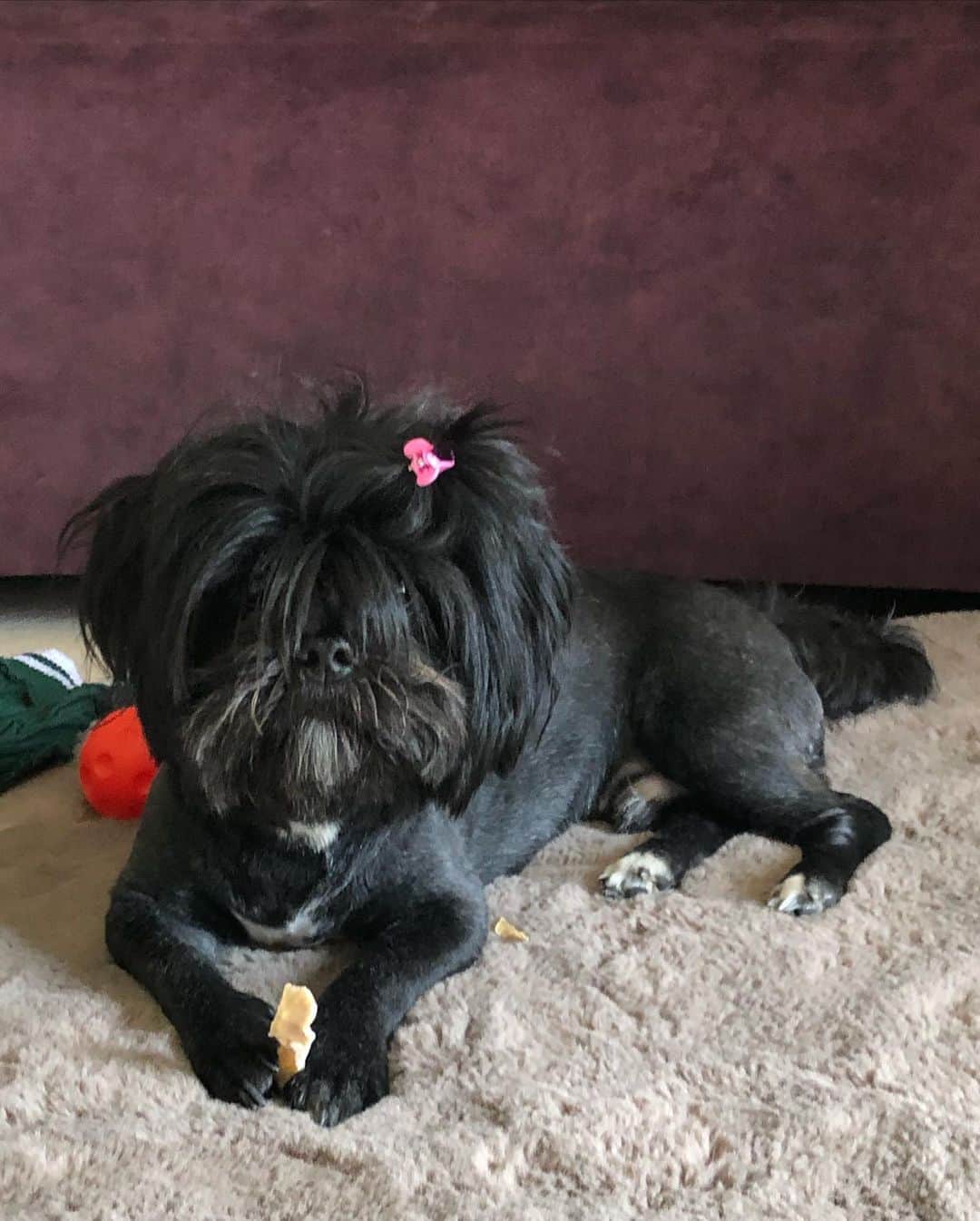
Photo from: @plutttoooooo
There is a chance that a purebred Lhasa Apso will be born with a solid black coat. Solid black Lhasa Apso dogs can be registered with the AKC.
In order to appear solid black in color, the Lhasa Apso dog must have three color-coding genes:
• B for black pigmentation;
• D for dense coloration;
• C for full color.
All of the genes that are in charge of coloring and making the Lhasa Apso’s coat shiny and thick must be dominant genes. Solid black Lhasa Apsos do not have any different colored hairs or a “black mask”.
An interesting fact is that only around ten dog breeds have a high chance of being solid black. Solid black coat colors can be seen in gorgeous black German Shepherds and funky black Poodles.
The solid black Lhasa Apso puppy is quite rare and its appearance in the litter surprises any dog owner or breeder!
4. Golden Lhasa Apso
https://www.youtube.com/watch?v=yxy5wV79eqw
But, the golden Lhasa Apso color should not be mistaken for the red gold Lhasa Apso coat color. Here’s the difference.
The golden color derives from brown and yellow coat color pigments. In other words, the golden Lhasa Apso comes in a pale gold to wheaten. The golden shine of a Lhasa Apso’s long coat really makes a big difference.
The gold colour is not as vivid as it is in Golden Retrievers. Golden Lhasa Apsos are pale gold, similar to some popular Goldendoodle colors.
More often than not, breeders cross Lhasa Apso puppies with purebred Golden Retrievers, which results in the Goldenapso Retriever. This is one of the rarest Golden Retriever mixes, but it is also one of the most adorable hybrids!
The Goldenapso Retriever carries color genes from both its parent breeds.
So, the chances are high that it will inherit a golden, smooth and soft coat from its Golden Retriever parent. However, the Goldenapso Retriever’s coat may be as long as that of its Lhasa Apso parent.
5. White Lhasa Apso
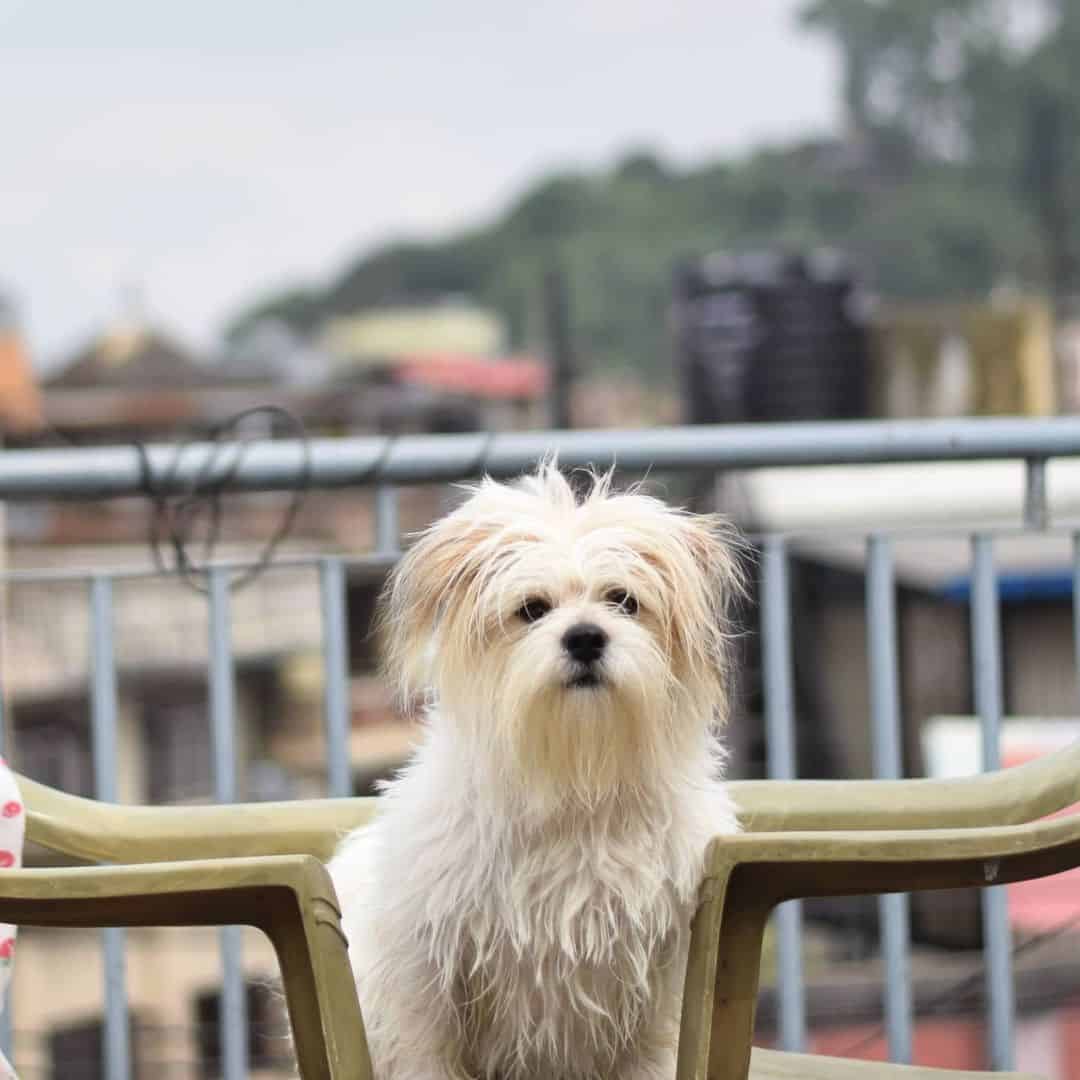
Photo from: @pukks.and.maichu
While most Lhasa Apso puppies inherit multiple coat color shades, white Lhasa Apsos inherit a completely white coat. Solid white!
This means that the whole of this Lhasa Apso’s coat is as white as snow! And I’m talking about the white Maltese kind of color.
The white coat color on the Lhasa Apso breed is recessive, which means that there are not going to be many white Lhasa Apso puppies. This is why some Lhasa Apso breeders value white pups more than cream, red, or black and tan pups.
White Lhasa Apsos are perfect candidates for creative white dog names! If you happen to purchase a white Lhasa Apso, make sure to give it a fun name that it deserves!
Due to the fact that most paw lovers believe that white dogs may have canine albinism, we must note that white Lhasa Apsos are not albino dogs.
Even though the rare albino Lhasa Apso may appear, it is still not considered as a white Lhasa Apso. Like most dog breeds, albinism in Lhasa Apsos is undesirable.
6. Black & Tan Lhasa Apso
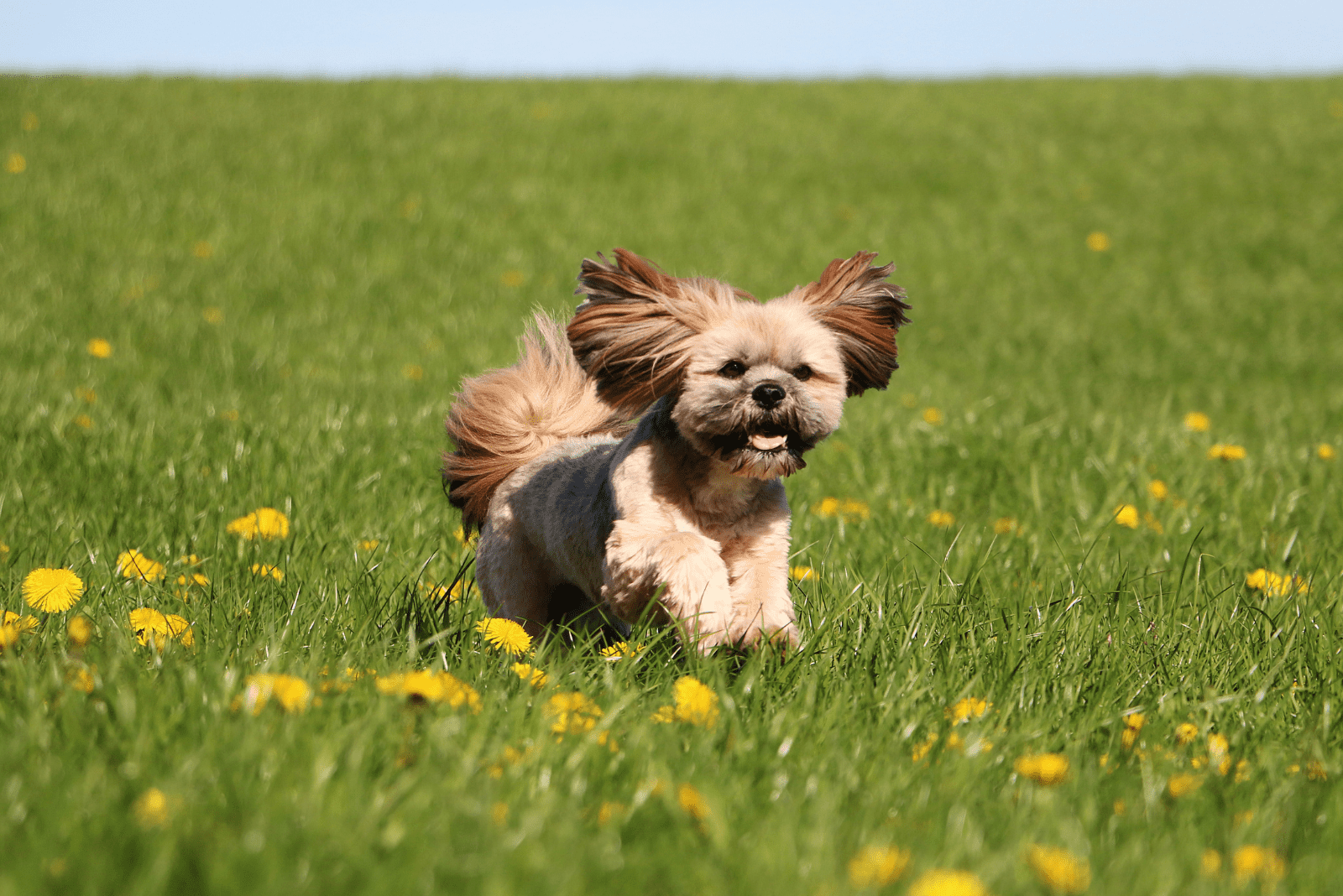
Black and tan is a color often seen in big dogs like Doberman Pinschers, German Shepherds, and Rottweilers. Well, the little Lhasa Apso dog is joining the black and tan canine crew!
In black and tan Lhasa Apsos, tan color markings are similarly distributed across its body like they are in Doberman Pinschers.
However, Lhasa Apsos have long hair, and Doberman’s don’t. And this makes a big difference. But, there are also some white markings that make the black and tan Lhasa Apso stand out from other black and tan dog breeds.
Black and tan Lhasa Apsos’ base body color is pure black, but they inherit adorable tan spots above the eyes and around the nose. The tan patterns also spread across the Lhasa Apsos’ chests and limbs.
Due to the fact that white markings often lean towards light cream color, light cream markings can be mistaken for white ones.
Because of the white markings that can cover the tan ones, this color is frequently misidentified as solid black.
7. Cream Lhasa Apso
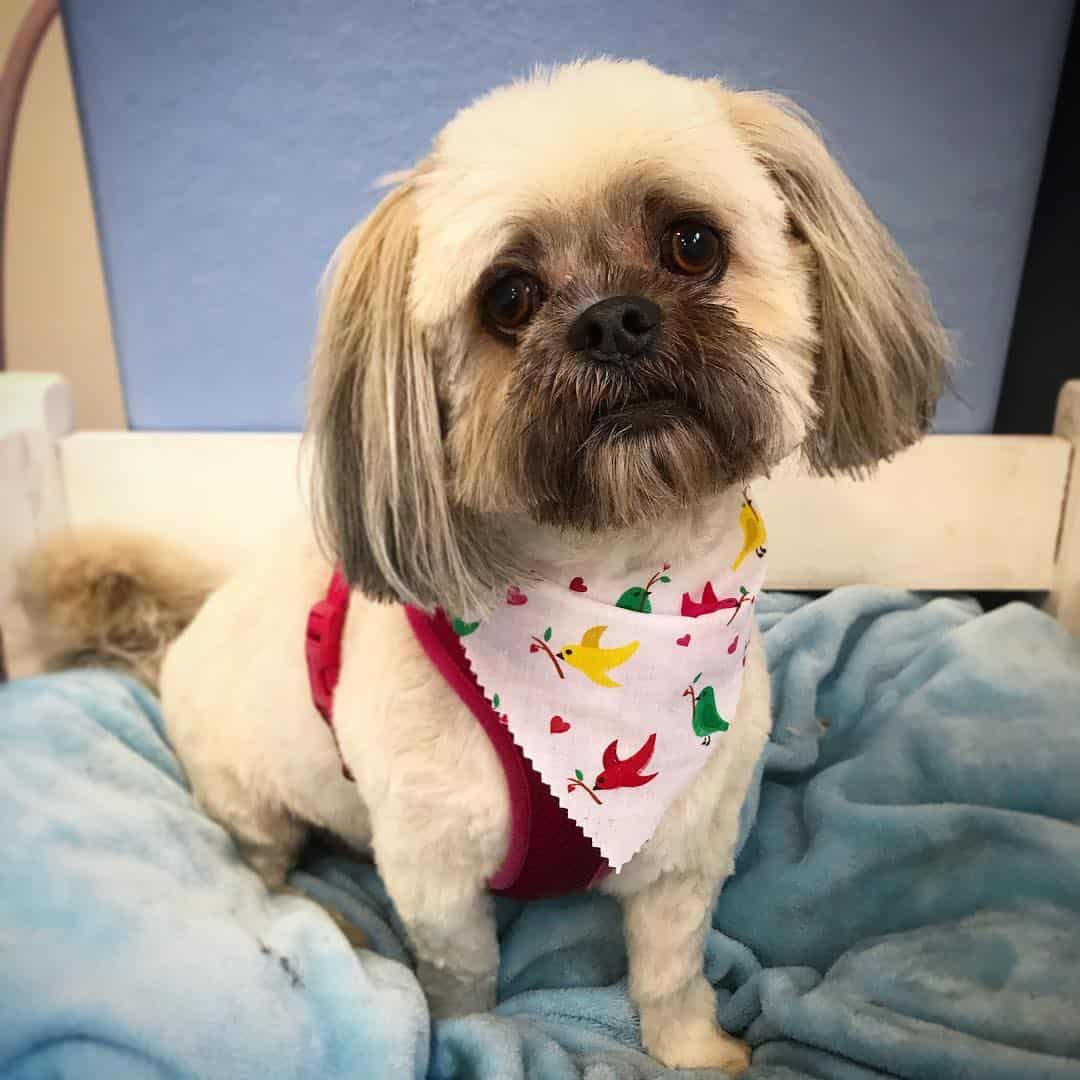
Photo from: @puppylovegroom
As we previously mentioned, white and cream colors are similar and can be easily mixed up. So sometimes, people think that cream Lhasa Apsos are white.
When you take a second look, you can notice darker shades of cream and beige.
Most cream Lhasa Apsos produce sable colored puppies because the cream color changes its hue. Comparison wise, most cream Lhasa Apsos look similar to the cream long haired Dachshund and the cream Shiba Inu puppy.
Usually, cream Lhasa Apsos inherit brown markings across their back and on their little fluffy ears.
8. Red Lhasa Apso
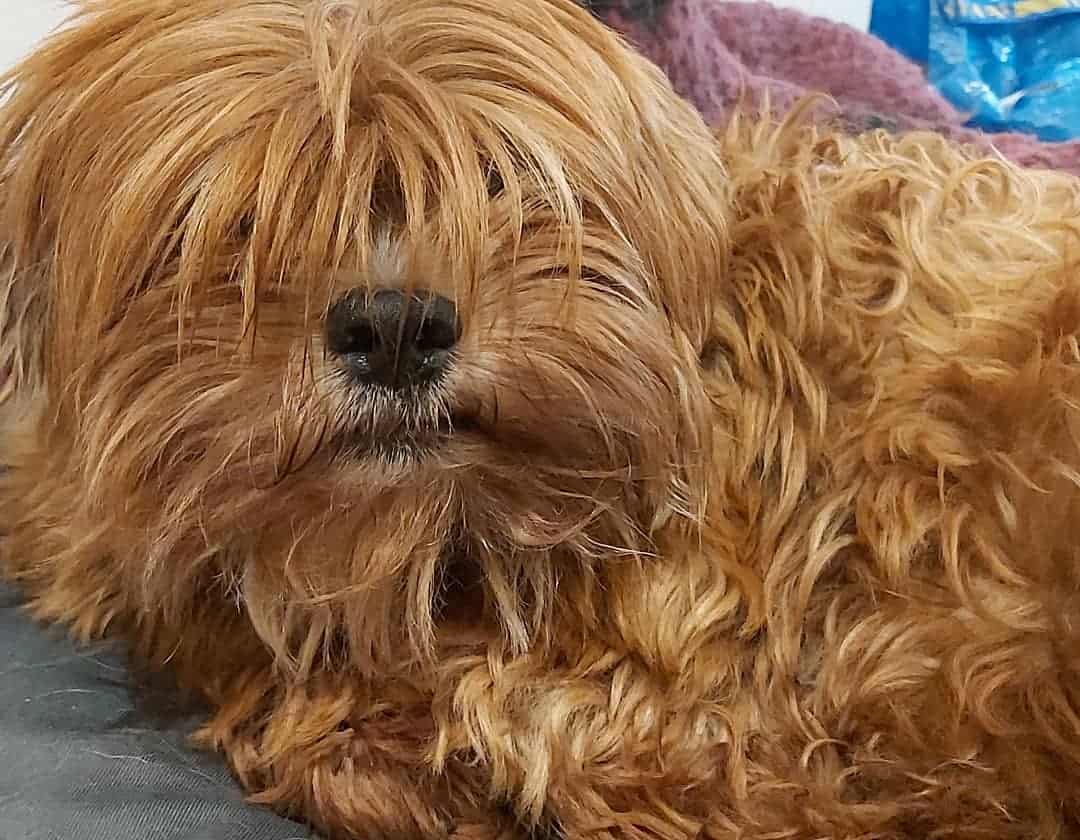
Photo from: @forsmanpia
The red Lhasa Apso is full of different color shades. The long coat of a red Lhasa Apso is usually a bit darker across the back. There are dark brown, white, and black hairs across its vivid red coat.
Red Lhasa Apsos can come in a very lively chestnut red color, but they can also inherit a more diluted, red-colored coat. Perhaps the closest red to the diluted red Lhasa Apso pup is the red Shih Tzu.
When the Lhasa Apso’s red coat is lighter in color, most paw lovers mistake it for a golden or cream coat.
What Are The Other Lhasa Apso Colors?
If you thought that there were only eight Lhasa Apso colors, you were wrong! The Dalai Lama’s favorite pooch has a lot more to offer!
These Lhasa Apso colors are often called “alternative colors”.
Even though these next Lhasa Apso colors are not recognized by the AKC and are disqualifying traits, we can’t help but fall in love with them!
A Lhasa Apso puppy’s coat is so shiny and smooth, that it would be quite a pity not to mention the other shades and hues it can be colored in.
Are you ready? Let’s say a few words about each popular Lhasa Apso color that, according to the breed standards, won’t pass in dog shows.
1. Gray
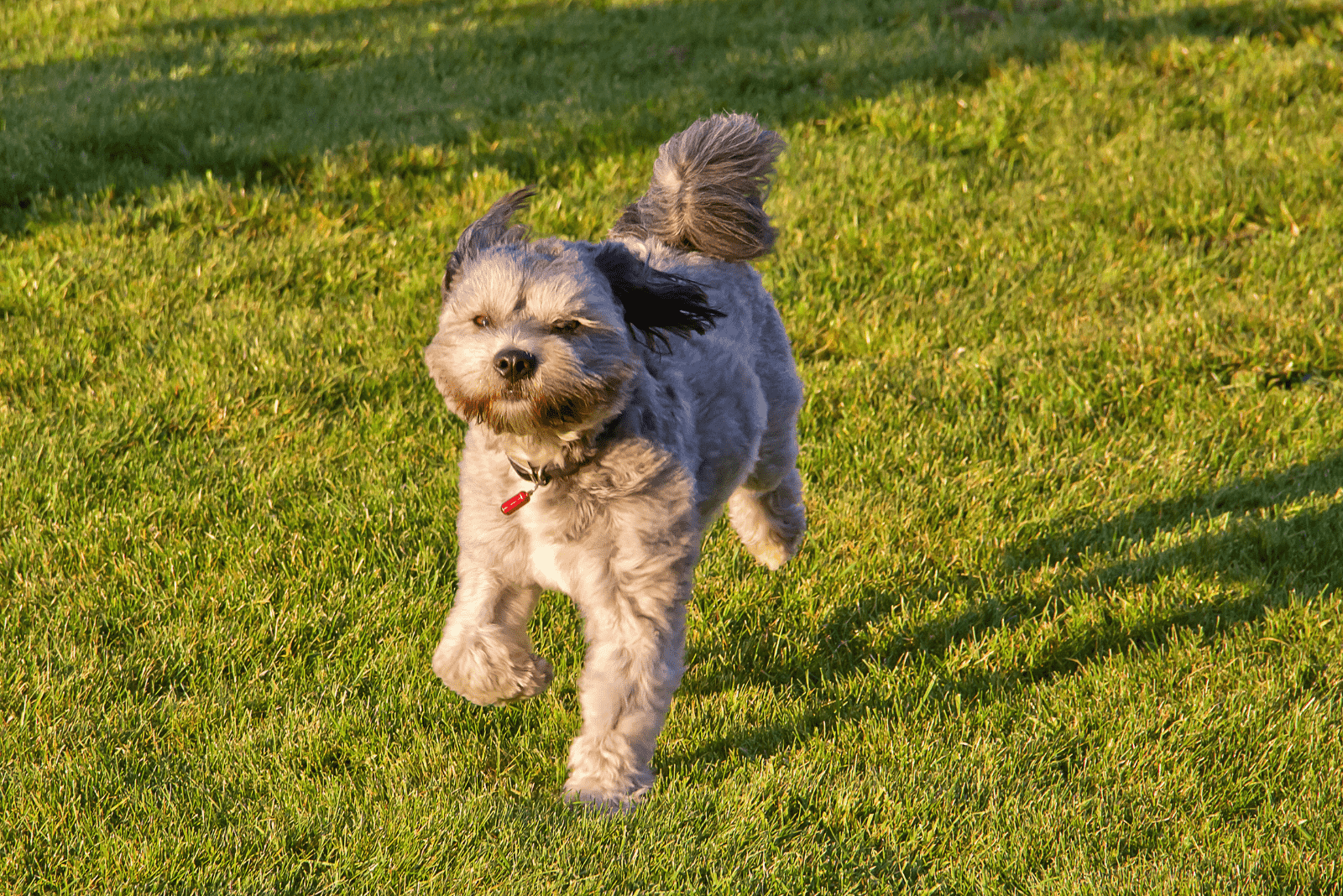
Most Lhasa Apsos that come in a gray color derive from brown or black parents. In fact, the gray color we see in most dog breeds, like the Gray Ghost Weimaraner, derive from the dilution of brown or black pigmented coats.
In Lhasa Apsos, their gray coats come in a variety of shades such as blue, light charcoal or grizzle. The blue coated Lhasa Apsos usually have a blue-ish tint across their coats when they are standing out in the sun.
Most gray Lhasa Apsos have white markings across their muzzles, paws, ears, and chests. Gray Lhasa Apso puppies are brown eyed wonders that will steal your heart!
2. Silver
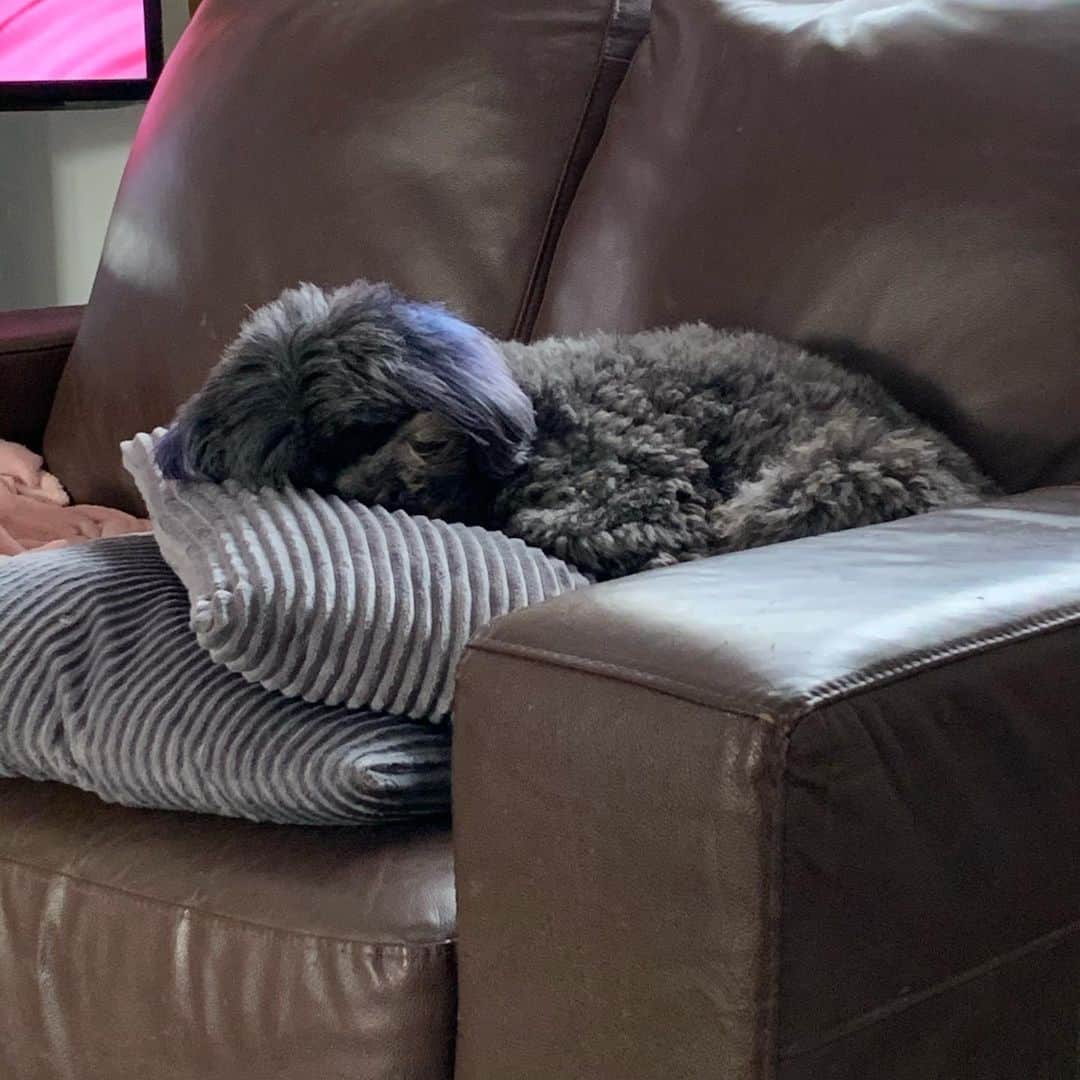
Photo from: @the.life.of.alfie_kenzo_keko
The silver Lhasa Apso is quite similar to its gray counterpart. The main difference is in the color shade and the light to white marking distribution on its body.
Silver Lhasa Apsos are very unique and they are very different from other silver dog breeds, like the silver Shih Tzu.
The silver Lhasa Apso is a combination of different colors and shades—they are combinations of cream sable, cream and black, and cream grizzle to gray.
What makes the silver Lhasa Apso stand out is its silver coating across its fluffy tail. For those Lhasa Apso puppies that inherit a kink at the end of their tail, it is mostly colored in shades of silver and cream.
A Lhasa Apso’s undercoat is also colored in silver, while its outercoat is a mixture of black and silver hairs.
3. Liver
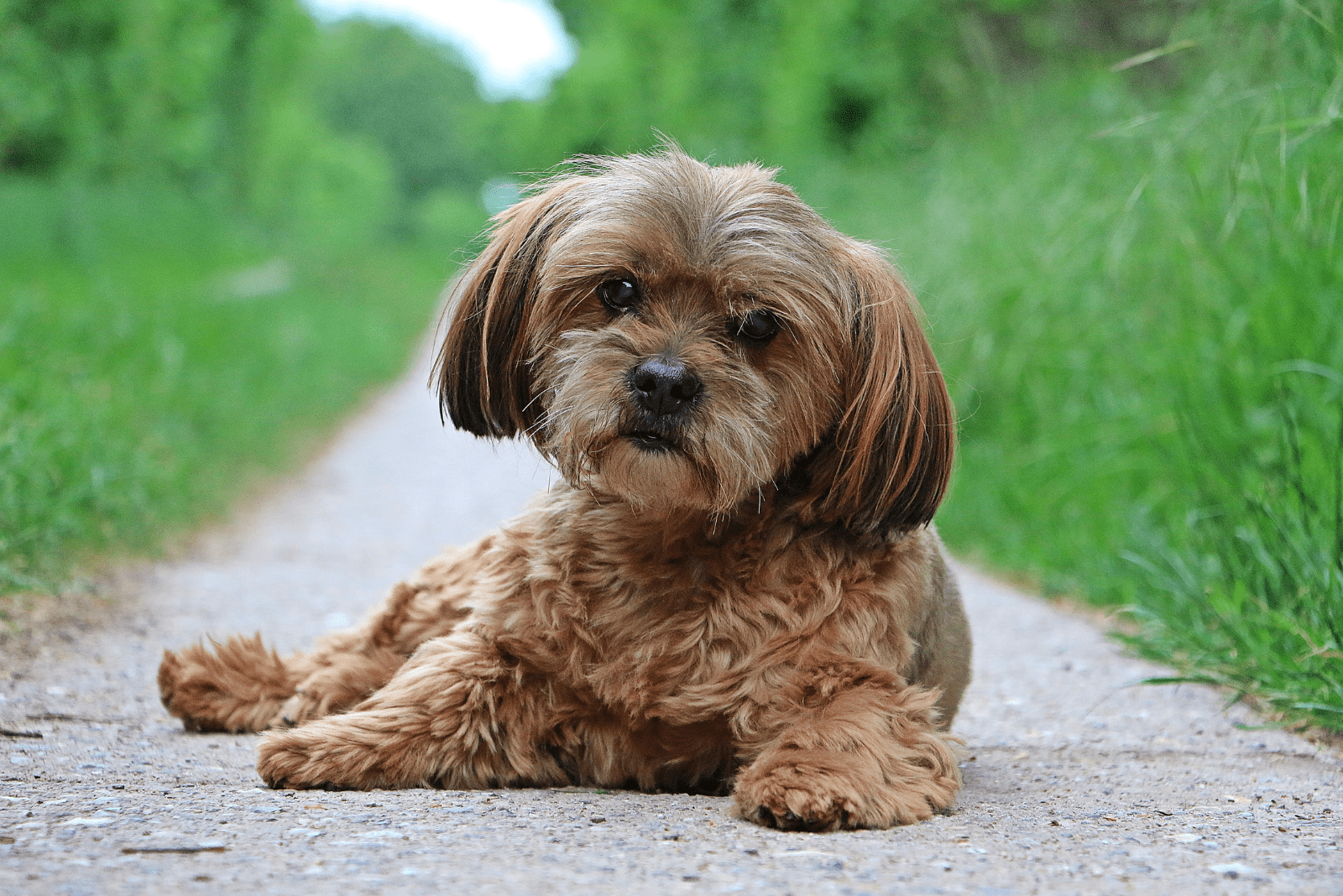
When someone mentions liver, the first thing that comes to my mind is a shade of brown. Well, the liver Lhasa Apso is a shade of brown with a twist!
Here’s the thing, the liver Lhasa Apso almost never inherits a solid liver color. It usually inherits white markings that are evenly distributed around its paws, legs, tip of the tail, muzzle, and chest.
Lhasa Apsos’ liver color is not as intense as the liver German Shepherds’. It is more of a light and soft liver color that is perfectly blended with white markings across the Lhasa Apso’s body.
4. Charcoal
The color of charcoal in the Lhasa Apso breed is quite rare. It is believed that this herding dog acquired the charcoal coat color due to intensive selective breeding.
The charcoal Lhasa Apso can come in dark or light faded black hues. Similar to the gray Lhasa Apso. But, in contrast to gray Lhasa Apsos, charcoal Lhasa Apsos have different markings on their bodies.
Most charcoal Lhasa Apso puppies inherit cream or white colored ears. The rest of their body is usually a light gray color.
5. Blue
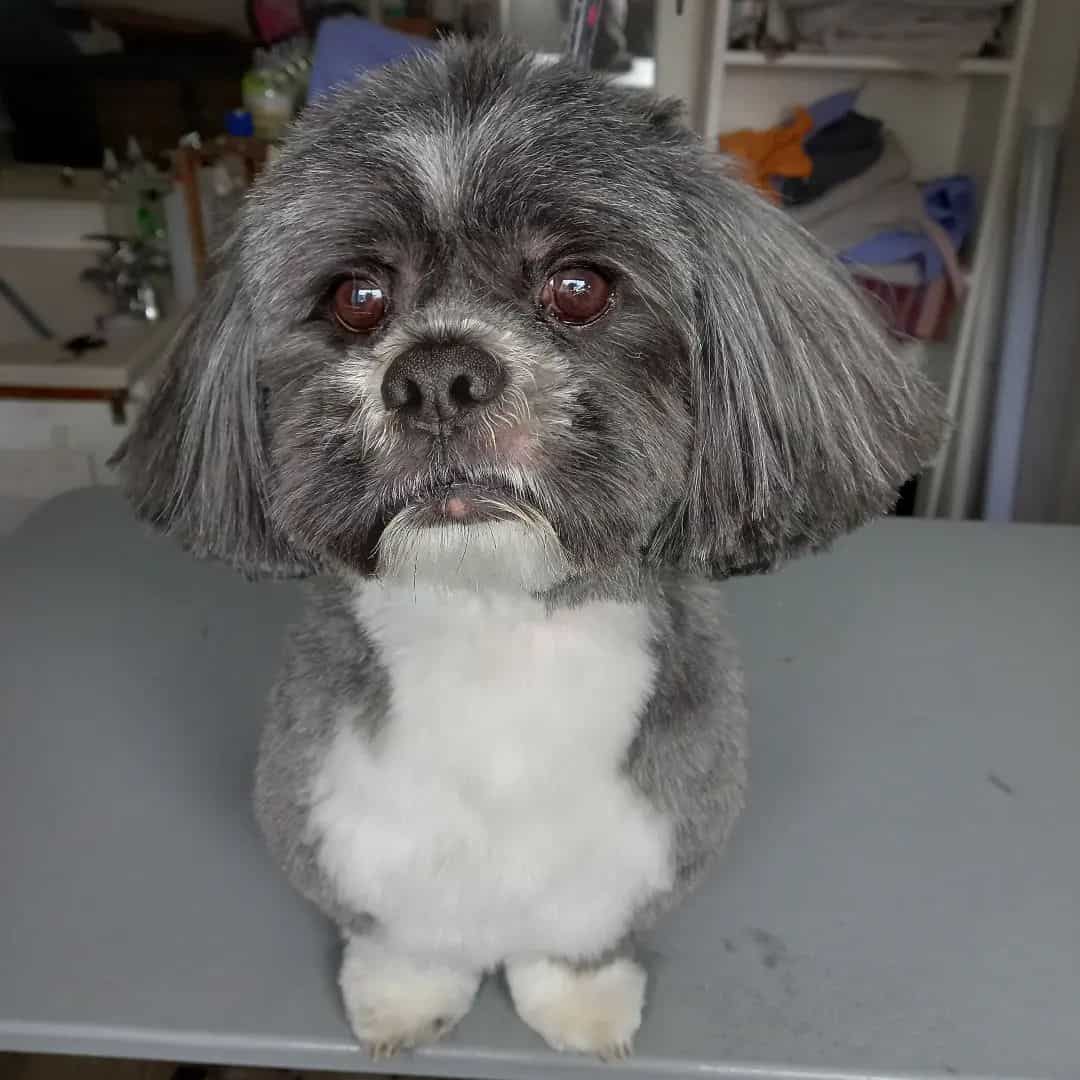
Photo from: @mutzcutzhull
In reality, blue Lhasa Apso puppies are not solid in color like, for example, the blue Blue American Bully. Their coats have gray colors and shades of light charcoal, but some of their hairs reflect a bluish tint.
Moreover, blue Lhasa Apsos inherit white markings on their muzzles and chests.
Most paw lovers and veterinarians believe that blue colored Lhasa Apso puppies are at a high risk of developing blue dog syndrome.
This may or may not be true. After all, it greatly depends on the quality of the breeding program. The healthier the Lhasa Apso, the longer the Lhasa Apso life expectancy is!
Lhasa Apso Markings
Okay, you’ve probably noticed all this talk about Lhasa Apso markings. So, to put it simply, common Lhasa Apso markings are:
• blac;k
• white;
• brown;
• cream.
But, are there more Lhasa Apso markings in this world?
Lucky for you, there are!
The majority of purebred Lhasa Apso don’t come in solid coat colors. In other words, most of them inherit different markings and patterns that are evenly, or unevenly, distributed across their long-haired bodies. These are especially noticeable in short-haired Apsos!
Because of this, the Lhasa Apso breed is truly remarkable and unique—no Lhasa Apso puppy is the same!
1. White Markings
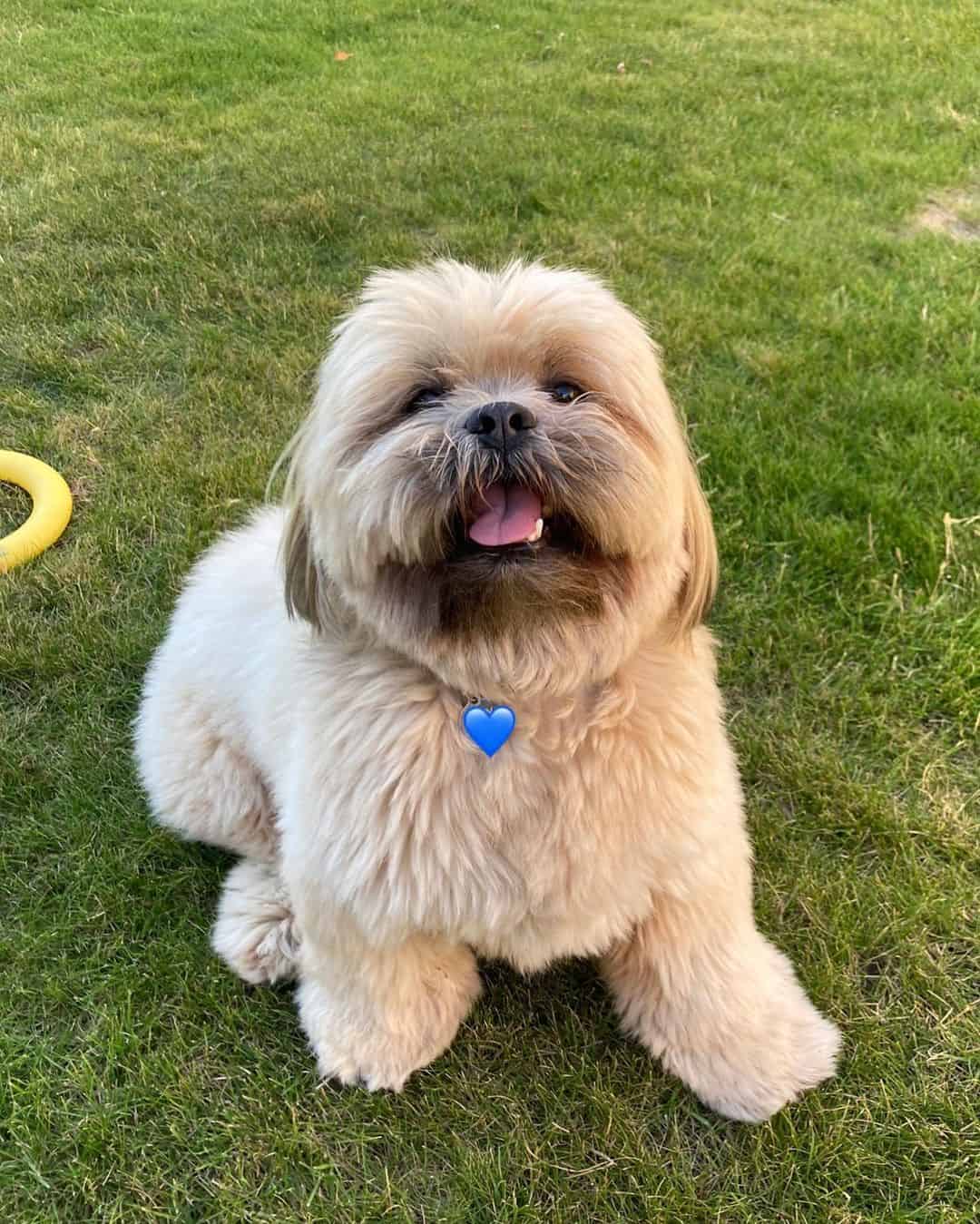
Photo from: @mr_tibsy
White markings are present on any colored coat. Whether it’s a cream Lhasa Apso, or a red one, the white markings are typically found on the chest, muzzle, tip of the tail, and muzzle blaze.
White markings are nothing new in the canine world. Similar white markings are found across base colors of Border Collies and Corgis.
2. Sable Markings
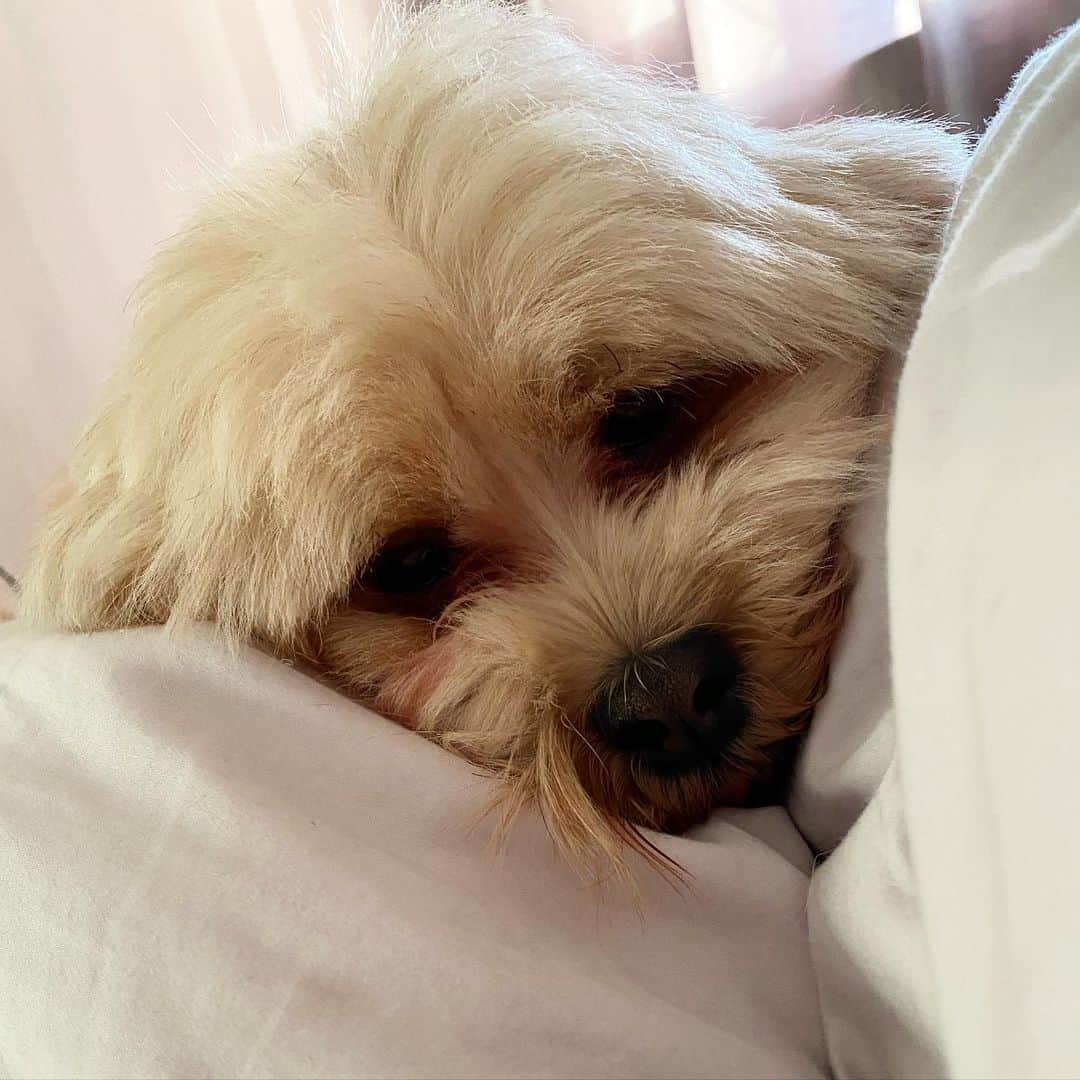
Photo from: @austin_quinn1
The sable coat color is a very unique blend of cream, gold, and liver tones. Often seen in French Bulldogs, the sable is composed of varying proportions of hairs in both light and dark colors.
In the Lhasa Apso breed, sable markings are color patterns created by black-tipped hairs that are overlaid on a gold, cream, red, or red gold base color.
3. Parti-color
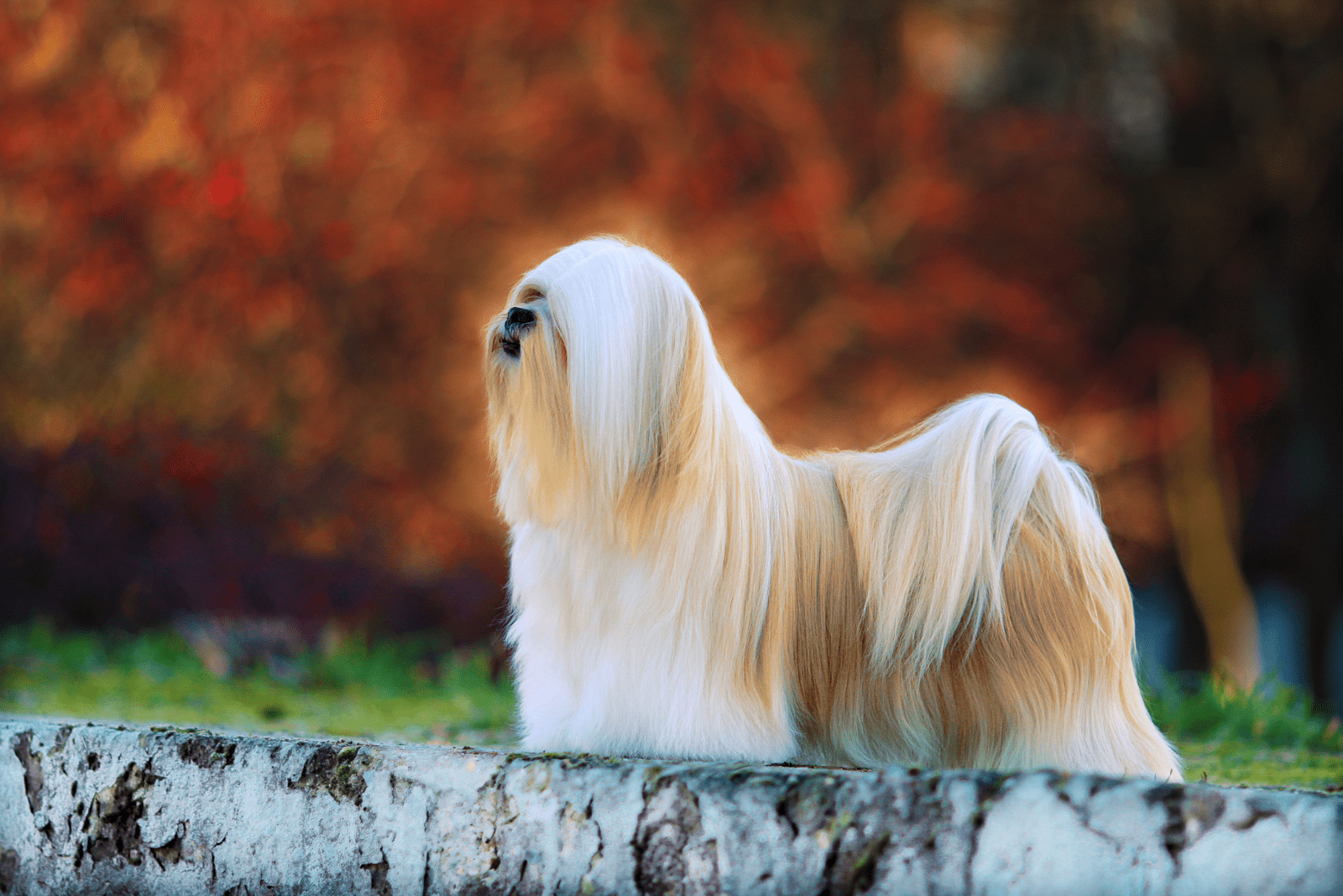
A pattern of two colors, usually white and another color, proportioned evenly on a coat is known as a parti-color. This interesting blend of colors is seen in parti Poodles and parti Schnauzers.
Parti Lhasa Apsos are very colorful dogs that have half of their body colored in white. The other half is composed of black, cream, brown, red, or blue patches!
Most parti Lhasa Apsos come in a combination of three (or more!) coat colors.
4. Brindle Markings
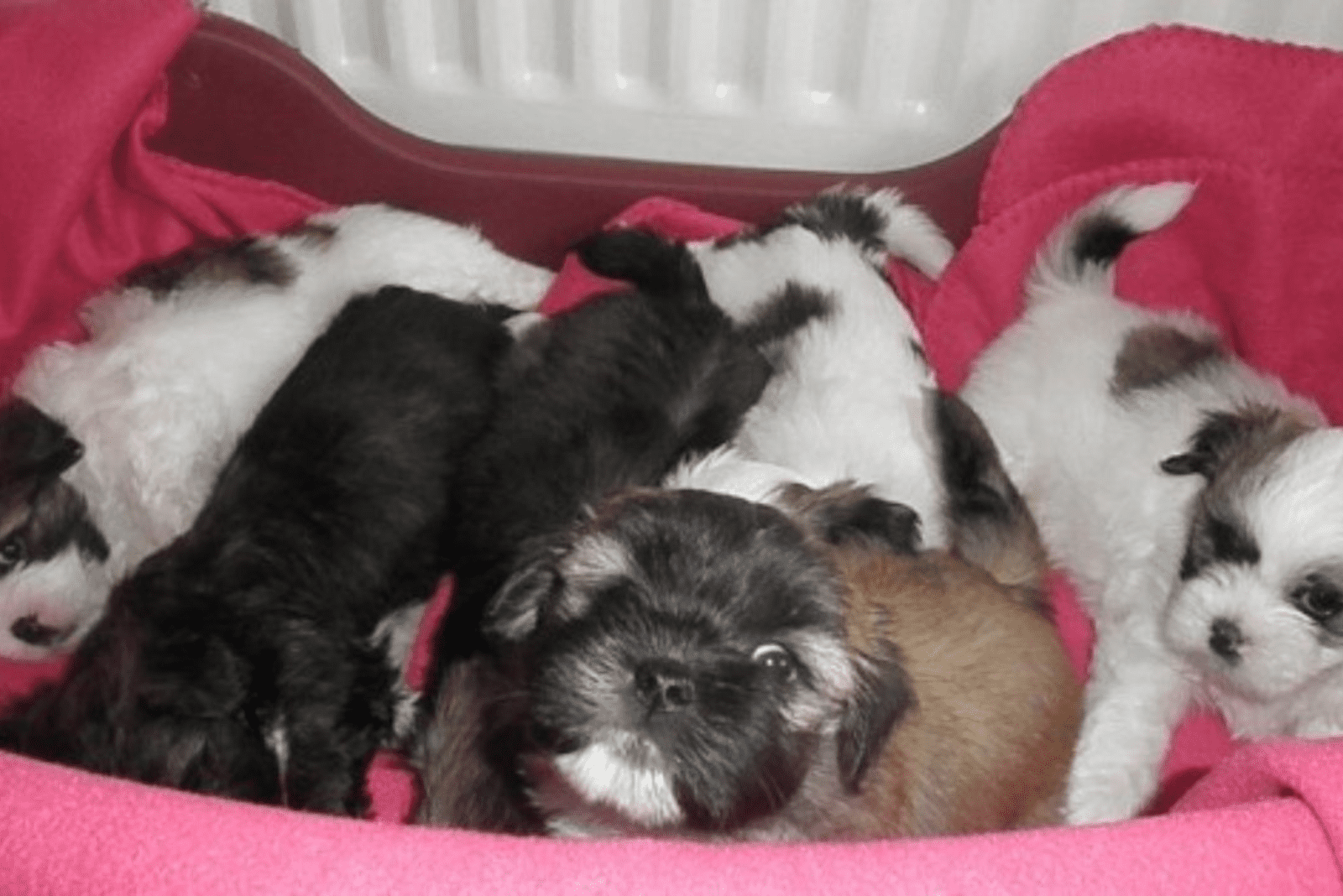
Oh the wonderful combination of brindle markings on a light or dark colored Lhasa Apso coat! Although brindle markings are rarely seen in the Lhasa Apso breed, they still exist and make this little dog look like a small tiger!
Brindle markings are dark colored patterns that are produced by the presence of dark brown or black hairs that form bands, which give a striking tiger effect on our Lhasa Apso pups!
Its counterpart, that also originates from Tibet—the Shih Tzu, also comes in brindle markings!
5. Black Tips
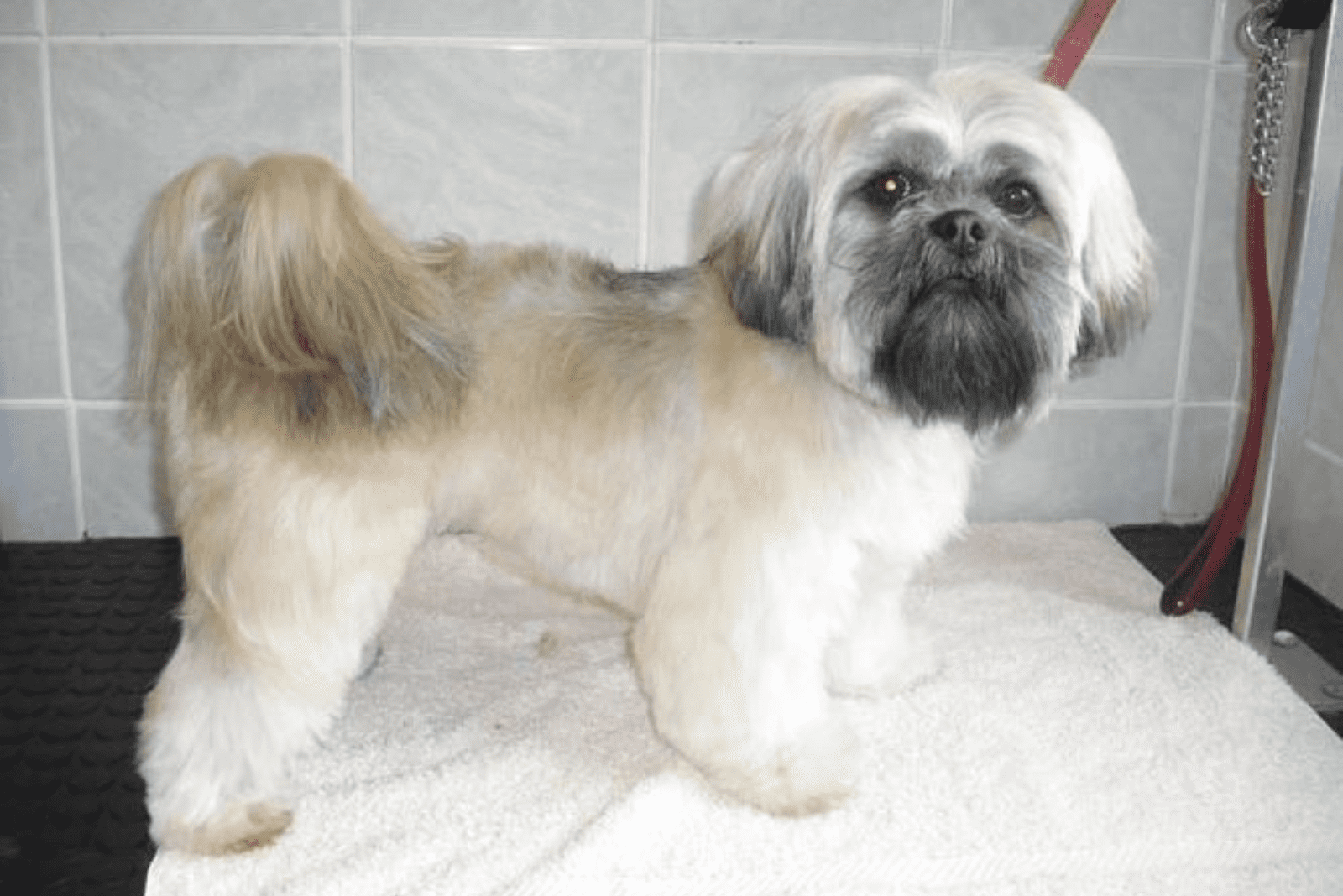
Black tips are specific black markings of the Lhasa Apso breed. Black tips are located on the Lhasa Apso’s face.
For some reason, a lot of people get confused about black tips in dogs. But, they are nothing more than black colored ends of Lhasa Apsos’ hair.
Black tips in the Lhasa Apso breed are usually located on the tip of the tail (kink) and around the muzzle. Most Lhasa Apsos have black tips at the end of their long hairs that fall down to the floor.
The dark shading creates a ripple effect while the long hair is moving. Black tips also add to the beauty of the long Lhasa Apso coat.
On light-colored Lhasa Apso coats, darker hairs appear to be streaked or heavily speckled; the full hair is colored, not just the tips.
6. Black Mask
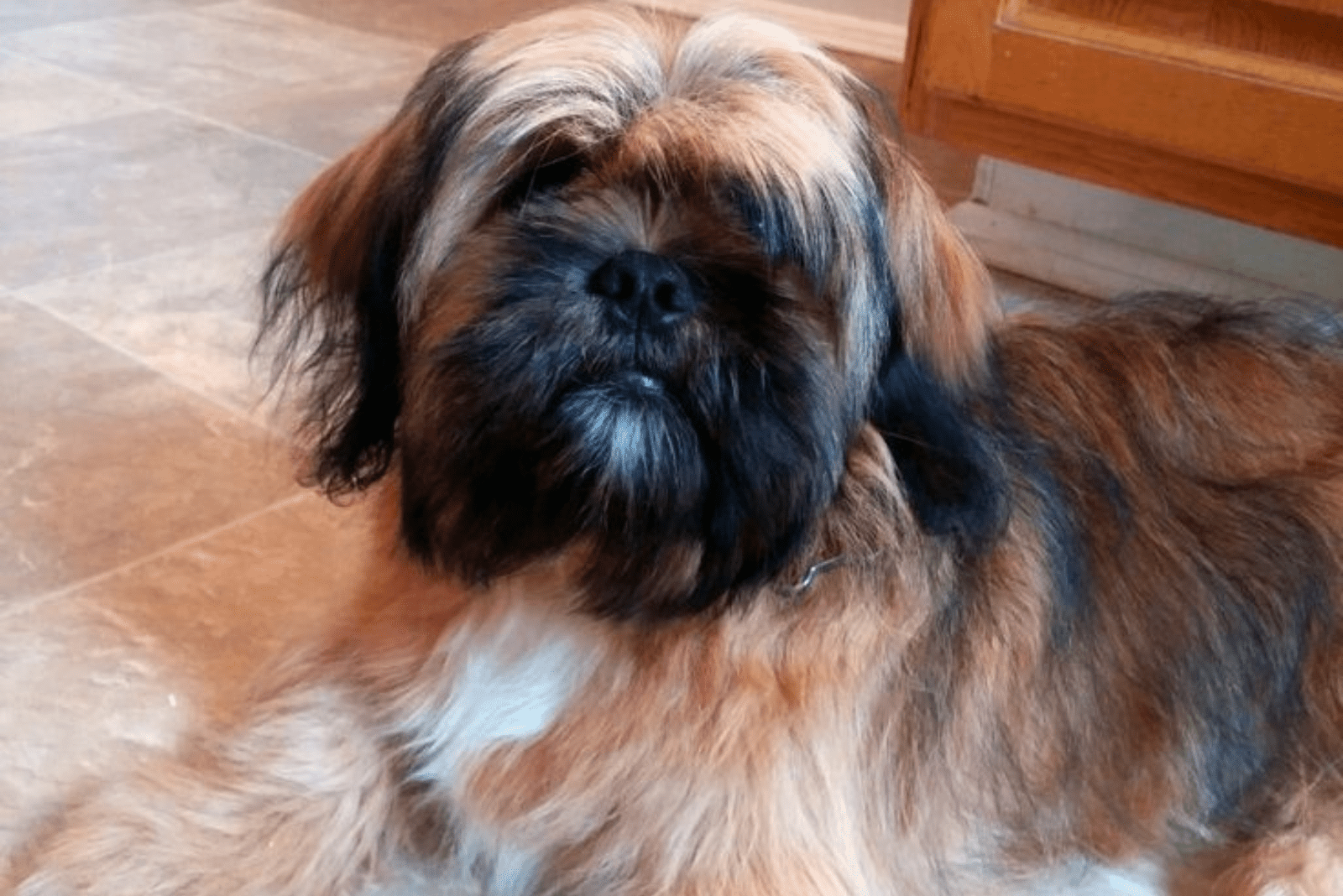
Lhasa Apsos are known for their black mask with tips, including pointed ears, tails, and dark shading or black on their faces.
Because of their black and white colors and similar appearance to purebred Shih Tzus, most Lhasa Apsos with black masks are mistaken for black and white Shih Tzus.
Do Lhasa Apsos Change Color?
Short answer: yes, they do! Well, some Lhasa Apsos do and some don’t. So, what gives?
At 8 weeks of age, some Lhasa Apso puppies acquire a dark brown color around the eye area. But, when they turn about 4 months of age, the dark-colored fur around their eyes turns white or cream.
Perhaps this is due to the longer and denser white hairs that develop around the Lhasa Apso’s muzzle as they age.
Most Lhasa Apso breeders have brown puppies that turn golden or cream once they mature! In contrast to light-colored puppies, solid black Lhasa Apso puppies remain black for the rest of their lives.
Final Thoughts
A cheerful and sometimes puckish family buddy—the Lhasa Apso is a fun pooch that makes everyone laugh.
Theoretically, Lhasa Apsos belong to the AKC non-sporting group. They are perfect lap dogs, but little did we know that Lhasa Apsos are actually fearless watch dogs! So, alongside a perfect cuddle bug, you also get an alert watchdog.
It’s hard to choose one from among the many beautiful Lhasa Apso colors.
These long-haired Tibetan pooches need quite a lot of maintenance, because their long coats are prone to matting.
If brushing out your Lhasa Apso daily is not enough and you still stumble upon those pesky tangles, you might have to consider hiring a professional groomer. Visiting a groomer helps keep Lhasa Apso colors vivid and their luscious coats fine and dandy.
Additionally, you could take your Lhasa Apso for a fancy puppy cut!
Related Content
Labrador Colors: The Pinwheel of Colors and Markings
